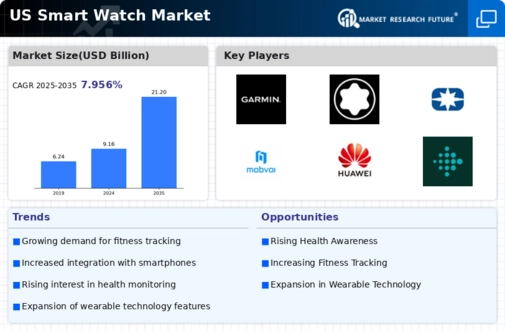Increased Smartphone Penetration
The proliferation of smartphones in the US is a key driver of the smart watch market. As smartphone ownership continues to rise, consumers are increasingly seeking complementary devices that enhance their mobile experience. In 2025, smartphone penetration in the US is estimated to exceed 85%, creating a fertile ground for smart watch adoption. The seamless integration of smart watches with smartphones allows users to receive notifications, track fitness, and access apps directly from their wrists. This connectivity not only enhances convenience but also encourages consumers to invest in smart watches as an extension of their smartphones. Consequently, the smart watch market is likely to see sustained growth, driven by the symbiotic relationship between these two device categories.
Rising Health Awareness Among Consumers
The growing awareness of health and wellness among consumers is significantly impacting the smart watch market. As individuals increasingly prioritize fitness and preventive healthcare, the demand for smart watches equipped with health tracking features is surging. In the US, approximately 60% of consumers express interest in wearable technology that monitors health metrics. This trend is further fueled by the desire for real-time health data, enabling users to make informed lifestyle choices. The smart watch market is thus positioned to benefit from this heightened focus on health, as manufacturers continue to innovate and offer products that cater to these needs. The potential for growth in this sector appears substantial, as more consumers seek to integrate health monitoring into their daily routines.
Growing Demand for Fashionable Wearables
The smart watch market is witnessing a shift towards fashionable wearables, as consumers increasingly seek devices that reflect their personal style. This trend is particularly pronounced among younger demographics, who view smart watches as both functional gadgets and fashion accessories. In 2025, it is estimated that nearly 40% of smart watch buyers prioritize design and aesthetics alongside functionality. Manufacturers are responding by offering a diverse range of styles, materials, and customizable options, appealing to a broader audience. This emphasis on fashion is likely to attract new consumers to the smart watch market, further driving sales and market expansion. As the line between technology and fashion continues to blur, the potential for growth in this segment appears promising.
Expansion of E-commerce and Retail Channels
The smart watch market is benefiting from the expansion of e-commerce and retail channels, which enhance accessibility for consumers. With the rise of online shopping, consumers can easily compare products, read reviews, and make informed purchasing decisions from the comfort of their homes. In 2025, online sales are projected to account for over 50% of total smart watch sales in the US. Additionally, traditional retail outlets are increasingly incorporating smart watch displays, allowing consumers to experience the products firsthand. This dual-channel approach not only increases visibility but also caters to diverse shopping preferences. As e-commerce continues to grow, the smart watch market is likely to see increased sales and a broader customer base.
Technological Advancements in Wearable Devices
The smart watch market is experiencing rapid technological advancements, which are driving consumer interest and adoption. Innovations such as improved battery life, enhanced sensors, and advanced health monitoring capabilities are becoming increasingly prevalent. For instance, the integration of ECG and blood oxygen monitoring features has attracted health-conscious consumers. In 2025, the market is projected to reach a valuation of approximately $30 billion, reflecting a compound annual growth rate (CAGR) of around 15% from previous years. These advancements not only enhance user experience but also expand the functionality of smart watches, making them indispensable tools for daily life. As technology continues to evolve, the smart watch market is likely to see further growth, driven by consumer demand for cutting-edge features.

























Leave a Comment